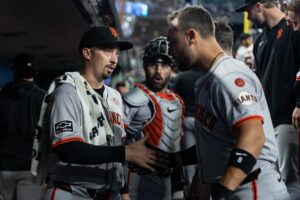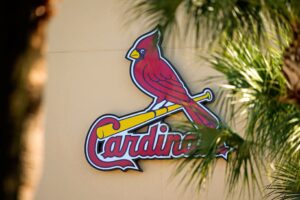In just a few days, pitchers and catchers will begin reporting to their respective teams’ Spring Training homes. This means one glorious thing: baseball is right around the corner. The 2016 season brought fans history and heartache, tragic losses and cathartic triumphs, and perhaps the greatest World Series in living memory. Needless to say, 2017 has a lot to live up to. With that in mind, and with the clock ticking down to Opening Day, it’s time to examine five burning questions for the 2017 MLB season.
Five Burning Questions for the 2017 MLB Season
1. Can the Chicago Cubs Repeat?
This is, of course, where we must start. The most important and historic story from the 2016 season gives us the most important question for 2017: after finally capturing a World Series championship for the first time in 108 years, do the Cubbies have what it takes to defend their title?
On paper, the answer is clearly yes. Chicago features some of the games brightest young stars; guys like Anthony Rizzo and Kris Bryant would be franchise cornerstones on and squad. Most importantly, however, the 2017 Cubs will look almost identical to the team that broke the Curse of the Billy Goat. Joe Maddon remains at the helm, that great rotation stayed intact, and the lineup will be, more or less, exactly as it was a year ago. True change really only struck the bullpen; Aroldis Chapman will close games for the New York Yankees this year. Yet, with Wade Davis coming in to fill the gap and Koji Uehara lending veteran savvy, the Cubs should not only weather the loss of Chapman, but thrive in his absence.
Again, however, that’s what things look like on paper. For all the similarity and all the projections, nobody yet knows what will happen when the bats start swinging. Slumps can strike even the greatest hitters, injuries are impossible to predict, and age eventually catches up with us all. Most of the Cubs are young, but Davis and Uehara are no spring chickens, and have been injured recently. Should they falter, a deep bullpen will suddenly look more like a liability. Bryant and Rizzo should have strong seasons again, but what of Addison Russell and Javier Baez? If they struggle and a couple other bats fail to get going, runs might start looking precious.
The answer, for now, is yes. The Cubs do have the pieces needed to repeat as World Champions. Until we see the product out on the field, however, we won’t truly know if they can do it.
2. What will Happen at the 2017 Trade Deadline?
This question actually looks ahead to the 2017-2018 offseason, which will feature one of the most loaded free agent classes ever. A list of every player set to hit the market would take up too much space, but names like Bryce Harper, Manny Machado, A.J. Pollock, Clayton Kershaw (who can opt out), and Matt Harvey represent just the tip of the proverbial iceberg. Some of these players will sign extensions before the July trade deadline, but most will test free agency after the season. Given the level of talent, money never before seen in the sport will change hands in the offseason, and many players will find new homes.
Some teams already know they won’t be able to keep their stars. Those not in contention for the playoffs by the deadline will look to deal, rather than wait and lose their players for nothing. Harper, for example, is reportedly seeking $400 million on his next contract, even after a down year in 2016. Machado is one of the best young third basemen around, and could get multiple hundreds of millions as well. The Baltimore Orioles might still keep him. The Washington Nationals, on the other hand, might already be preparing to lose Harper.
There are clubs out there that can afford to give these players, and others, the contracts they want, and that have the trade pieces to acquire them in July. The Yankees have been preparing for this free agent class for years; they’ve recently been dumping their veterans and big contracts, while at the same time stockpiling some of the best minor league talent around. Of course, theirs no guarantee that the Nats or any other team will be selling, but Harper might want to see how he looks in pinstripes anyway. Other teams could also be in the market to buy. If the trade deadline gets as chaotic as it very well might, the MLB landscape will look entirely different come August.
3. How will the Cleveland Indians Bounce Back from a Tough World Series Loss?
Just when it looked like Cleveland would best the Cubs and overcome their own World Series drought, fate decided it had other ideas. Much like Chicago, however, the Indians have a good chance of getting back to the Series in 2017. They return the vast majority of their lineup from last season, and added star slugger Edwin Encarnacion to the mix. They look like the preseason favorites to once again win the American League. The Boston Red Sox, on paper, appear to be their biggest threat.
Truth be told, if not for a few key injuries, the 2016 World Series may have gone very differently. Missing Carlos Carrasco and Danny Salazar, the Indians were forced to overwork Corey Kluber and rely too heavily on Josh Tomlin. Kluber performed as well as any pitcher in the postseason, but the innings caught up to him in the end, as they would any human. Tomlin was, well, maimed, and was just Josh Tomlin when he wasn’t. If Carrasco and Salazar had been healthy, the Cubs might be working on ending a 109-year curse this season. Assuming those two return fully healthy and the Indians avoid any other major injuries (again, impossible to predict), they’ll be tough to beat in October.
4. Will MLB Surpass $10 Billion in Revenue?
Reports of baseball’s demise have been greatly exaggerated in recent years. In fact, MLB is not only alive and well, but seems to be thriving. By the end of the 2016 calendar year, the league’s gross revenues were nearing $10 billion, and had reached record highs for the 14th consecutive season. Thanks to strong attendance figures, growth in TV ratings for the regular season and postseason, and the growth of MLB Advanced Media, there’s little reason to think the league won’t break through that $10 billion threshold.
Don’t expect the league to stop there, either. Thanks to the new labor deal, Major League Baseball will enjoy labor peace through 2021, extending what is already the longest peaceful stretch of the four major American sports. Given the growth in popularity even of smaller market teams and the wealth of young, marketable stars featured around the league, the next few years should see baseball reap unheard of profits.
5. Which Teams will Challenge the Establishment this Season?
The Cubs, Indians, and Red Sox appear, on paper, to be the strongest teams in the league. All three feature stacked rotations and balanced lineups. With that said, will any teams emerge to challenge them?
American League
The strength of the American League lies, for the most part, the the AL East. The Yankees, while young, are more talented than they get credit for. At the moment, their rotation serves as their biggest weakness. Yet, if their youthful sluggers pan out, New York could deal for pitching at the deadline. With help from another starter or two, the Yankees could at least secure a playoff berth. If that happens, they’ll have a chance to knock off either Cleveland or Boston.
The Toronto Blue Jays, as always, should also be dangerous. Though their lineup seems weakened by an aging Jose Bautista and the loss of Encarnacion, their rotation is highly underrated. If they trade for a bat and get hot at the right time, they could make some noise. In the AL Central, the Detroit Tigers, led by Michael Fulmer and Justin Verlander, should not be ignored. Finally, don’t sleep on the Houston Astros. After a strong offseason, they could knock off the Texas Rangers for the AL West crown.
National League
Over in the NL, the Nationals and the Los Angeles Dodgers should once again be the greatest threats to the Cubs. Both feature fearsome rotations, and the Nats can hit with anyone. Washington lacks a closer and the Dodgers lineup is a bit of a question mark. If those kinks get worked out, both clubs will be there come October.
The San Francisco Giants and Colorado Rockies also warrant attention. The Giants were a reliable reliever away from truly threatening the Cubs in the playoffs last season. The addition of Mark Melancon fixes that issue. The even-year streak ended, but an odd-year streak could be on the horizon. Colorado, for its part, enjoys promising talent up and down the roster. If they can keep from collapsing down the stretch, they might be hard to put away in September and October.
Main Photo:






